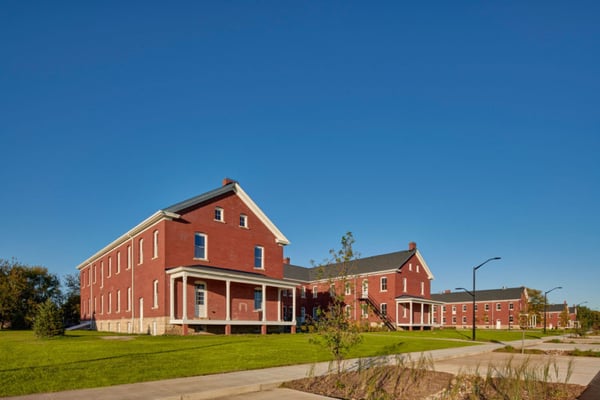4 Eligibility Requirements for Federal Historic Tax Credits

If you plan to rehabilitate a historic structure, the Federal Historic Preservation Incentive Program is an effective financing option. The program offers a tax credit equal to 20% of your rehabilitation costs. By leveraging this opportunity, you can minimize financial risk and increase your budget’s potential.
Unfortunately, not every project qualifies for tax credits. The program sets strict requirements related to the following:
- The building’s historic status
- The project’s scope
- The building’s planned use
- The proposed renovations
At Neumann Monson, we have worked on numerous projects that successfully utilized historic tax credits, including Market One in Des Moines, IA and MidWestOne Bank in Iowa City, IA.
We know that getting started with historic tax credits can be a confusing process, which is why we created a four-step guide to the program’s eligibility requirements. By the end of this article, you will know if your project qualifies for this unique form of financing.
1. Be a Certified Historic Structure
Only “certified historic structures” qualify for the 20% tax credit. Certified historic structures are buildings listed on the National Register of Historic Places or listed as “contributing resources” in nationally registered historic districts.
“Contributing resources” are buildings that add to the historical or architectural significance of a district. Generally, the National Park Service (NPS) establishes a period of historic significance for “contributing” buildings.
For example, buildings built between 1880 and 1930 may “contribute” but one built in the 1950s may not. Every historic district will have different requirements.
Becoming a Certified Historic Structure
Not sure if your building is a certified historic structure? Contact your local municipal planning office or your State Historic Preservation Office (SHPO).
If your building is not certified, you will need to work with a historian or architect to place your building on the National Register. If your building is a “non-contributing” resource in a historic district, you can apply to have its status changed.
Whether you attempt to list your building on the National Register or change its contribution status, you risk not getting approved. However, an experienced architect or historian can make a strong case and increase your chances of success.
2. Make a “Substantial” Investment
Along with the NPS, the Internal Revenue Service (IRS) administers the Federal Historic Preservation Tax Incentive program. According to the IRS, the cost of the rehabilitation must exceed the pre-rehabilitation cost of the building. Specifically, the rehabilitation must be $5000 over the building’s adjusted annual basis.
Calculating Adjusted Annual Basis
You can calculate your adjusted annual basis with the following equation:
The purchase price of the property – the cost of the land at the time of purchase – the deprecation from a tax-producing property + the cost of any capital improvements made to the property.
Here is an example: A few years ago, you purchased a Queen Anne-style home that you lease as a rental. You paid $200,000 for the property. At the time of purchase, the land was worth $80,000. Through renting, the tax value depreciated by $20,000. You also added a new HVAC system that costs $10,000.
To calculate the adjusted annual basis, you would calculate the following: 200,000 – 80,000 – 20,000 + 10,000 = $110,000. Therefore, you will need to spend at least $115,000 rehabilitating the building to receive your tax credit.
Note: Not every rehabilitation cost counts toward your tax credit. For example, outdoor amenities like parking lots and sidewalks do not contribute to the total. Check out our introduction to federal historic tax credits to learn which expenses qualify.

Fort Des Moines, a project that used federal historic tax credits.
3. Produce Income
To meet the IRS requirements, the building must also produce income. This means it will be used for commercial, industrial, agricultural, or rental purposes after the renovation is complete. Keeping with the previous example, the Queen Anne rental property passes the test.
The IRS specifies some minor exceptions to this rule. For example, if you rent a portion of your home as either an apartment or office, the rented portion may qualify for tax credits.
4. Follow the Standards of Rehabilitation
Lastly, the renovation must meet the Secretary of the Interior’s Standards for Rehabilitation. The Standards are designed to maintain a property’s significance and preserve its historic features. They apply broadly to buildings of all materials, construction types, and sizes. During the application process, the NPS will review your design and construction plans and determine if they align with the Standards.
Most of the Standards relate to retaining and preserving the building’s historic features. But the Secretary of the Interior allows new additions if the new work does not destroy the historic materials that characterize the property. The new work should also be differentiated from the old and should not give a false sense of historical development.
Designing Modern Additions
For example, on Market One, we added a conference room to the building’s rooftop. We used naturally weathering Ipe wood to blend the new addition into its historical setting. This choice of materials also differed from the building’s historic red brick, carefully delineating the conference room as a modern addition.
Despite these efforts, the NPS initially rejected the addition. After much debate (and a trip to Washington), we eventually received approval. This story demonstrates the rigor that goes into the planning process.
Even for experienced architects, the Standards of Rehabilitation are difficult to meet. To assure your project is approved, consult an architect who understands the nuances of the requirements and can defend and modify design decisions.
What Are Your Next Steps?
Each year, the Federal Historic Tax Incentive Program helps rehabilitate thousands of historic buildings. The program is an effective way to fund a rehabilitation project and mitigate financial risk. By ensuring your project aligns with the guidelines specified by the IRS, NPS, and the Secretary of the Interior, you can take advantage of this financing option.
At Neumann Monson, we have helped many clients apply for historic tax credits. If you are unsure if your project qualifies, reach out to an architect who can review your project and help you align your goals with the program’s requirements. To learn more about historic tax credits, read about the application process.